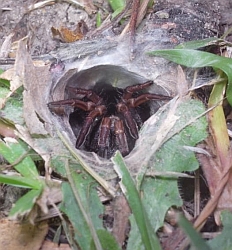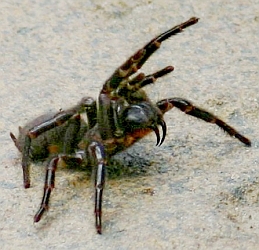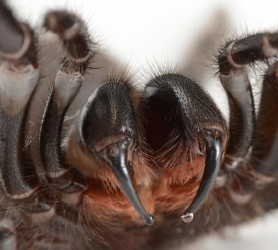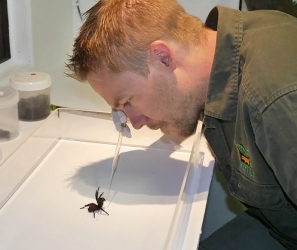  The Sydney Funnel web spider is a large aggressive spider that's black, the front of their bodies shiny and hairless and their abdomens dark plum in colour.
The Sydney Funnel web spider is a large aggressive spider that's black, the front of their bodies shiny and hairless and their abdomens dark plum in colour. There are 35 species of funnel web, a number of which are found along Australia's eastern coast, in and around the city of Sydney, but only the Sydney funnel web is considered to be world's deadliest spider. The scientific classification: Phylum: Arthropod Class: Arachnid Order: Araneae Family: Hexathelidae Genus: Atrax Species: robustus  The Sydney funnel web is generally found in both city suburbs and bushland, in an area centred around Sydney.
These large spiders burrow in sheltered sites under logs and rocks, where they can find a cool and humid climate.
The Sydney funnel web is generally found in both city suburbs and bushland, in an area centred around Sydney.
These large spiders burrow in sheltered sites under logs and rocks, where they can find a cool and humid climate.They rush out of their burrow, lined with silk in a funnel shape, when potential prey such as beetles, cockroaches, small lizards or snails, walk across trip-lines that the spider has placed around the outside of its burrow. They return to their burrow to eat.  They are relatively large spiders, ranging in size from 1.5 cm to 3.5 cm. One large male specimen, affectionately named 'Big Boy' by the Australian Reptile Park, reached 10 cm stretched out. They have large, rearward-facing fangs capable of piercing fingernails. If threatened, Sydney Funnel webs show aggressive behaviour, rearing and displaying their impressive fangs.
They are relatively large spiders, ranging in size from 1.5 cm to 3.5 cm. One large male specimen, affectionately named 'Big Boy' by the Australian Reptile Park, reached 10 cm stretched out. They have large, rearward-facing fangs capable of piercing fingernails. If threatened, Sydney Funnel webs show aggressive behaviour, rearing and displaying their impressive fangs. Males will leave their burrows and wander over the summer and autumn to find females and mate. Dry daytime conditions will dehydrate funnel web spiders, and also expose them to birds and lizards. This is why males that have spent the night in search of a female have to seek cover at dawn. Cover can be any hideaway that is dark, moist and cool, like under a rock, or even in a shoe left outdoors.   Male Sydney Funnel web spiders often wander into backyards, and sometimes fall into suburban swimming pools, where they can survive many hours. They also will enter houses. These spiders have one of the most toxic venoms (to humans) of any spider. However, not all funnel web bites are life-threatening. The venom of juvenile and female Sydney Funnel web spiders is much less toxic.  Nevertheless, a bite by a mature male Sydney Funnel web spider can be deadly. The venom has a neurotoxin component that attacks the human nervous system and, in the worst cases, can result in death. However, there have been no fatalities since the introduction of antivenom. After numerous fatalities and years of research, an antivenom for the Sydney funnel web was finally developed in 1981. There hasn't been a fatality since.
Nevertheless, a bite by a mature male Sydney Funnel web spider can be deadly. The venom has a neurotoxin component that attacks the human nervous system and, in the worst cases, can result in death. However, there have been no fatalities since the introduction of antivenom. After numerous fatalities and years of research, an antivenom for the Sydney funnel web was finally developed in 1981. There hasn't been a fatality since.
The Australian Reptile Park plays a vital role in the production of antivenom, with five staff dedicated to the country's only funnel web venom-milking program. [Image credit: Australian Reptile Park] Producing droplets of venom 1/500th the size of a water droplet, it takes about 70 milkings of a spider to produce one dose of antivenom, and requires a large collection of spiders to be sustainable. Every year, the park encourages Sydney residents to catch any funnel webs they encounter and drop them off at designated drop-off sites. Strangely, animals such as cats and dogs can survive a funnel web bite quite easily; their body neutralizes the toxin in about half an hour. Birds are also immune; chickens will eat them quite happily! |